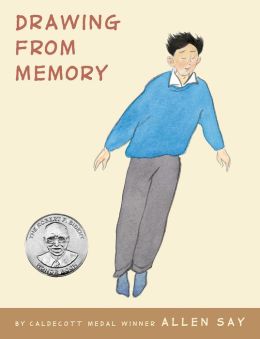
http://img1.imagesbn.com/p/9780545176866_p0_v1_s260x420.JPG
Say, Allen. 2011. Drawing From Memory. New York: Scholastic Press. ISBN: 978-0-545-17686-6.
Drawing From Memory is an autobiography telling the story of Say's unusual upbringing in postwar Tokyo. His determination to pursue life as an artist and the relationship he develops with the famous Japanese cartoonist Noro Shinpei after becoming Shinpei's apprentice is the centerpiece of the book.
Say uses an unusual mix of text and graphics to share his coming-of-age story and development as an artist. The front flap of the book describes the contents as, "Part memoir, part graphic novel, part narrative history..." Each page offers the reader an opportunity to appreciate Say's talents with words and illustrations created with watercolors, pencils, pen and ink, and photographs. Even the font used for captions is unique because it was developed specifically for the book based on Say's handwriting. Early sketches are included as well as examples of Noro Shinpei's cartoons that first captured Say's imagination and led to his desire to be a cartoonist much to his father's dismay. His father believed that, "Artists are lazy and scruffy people--they are not respectable." Luckily, teachers recognized his talent and supported his artistic endeavors including Shinpei who became Say's sensei and "spiritual father". Drawing From Memory is an engaging story, a beautiful artwork, and a loving tribute to a respected teacher that any reader will enjoy.
To learn more about Allen Say please visit the publisher's website: http://www.houghtonmifflinbooks.com/authors/allensay/author.shtml.
Lesson plans and activities that explore Allen Say and his books can be found here: http://www.webenglishteacher.com/say.html.
Publishers Weekly commented in their review, "As the story of a young artist's coming of age, Say's account is complex, poignant, and unfailingly honest. Say's fans—and those who also feel the pull of the artist's life—will be captivated."
Jeanine Fox writing for VOYA said, "The mixture of text, sketches, and photographs illustrates Say's development as an artist and provides a glimpse into his youth and the lives of those closest to him. This book is sure to appeal to reluctant readers. Its brief text and plentiful graphics make it a quick but fulfilling read, and leave the reader wanting more."
School Library Journal noted, "Illustrations are richly detailed and infused with warmth. Exquisite use of light makes night scenes glow, and the mid-20th-century Tokyo setting is captured with vivid authenticity. A variety of media and artistic styles, including full-color paintings, black-and-white sketches, photographs, and comic-book panels, adds texture and depth to the narrative."

